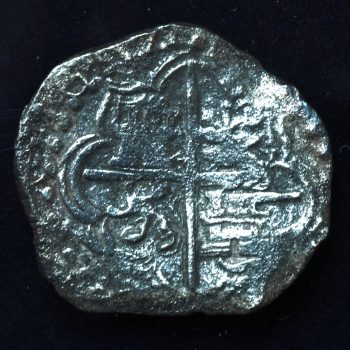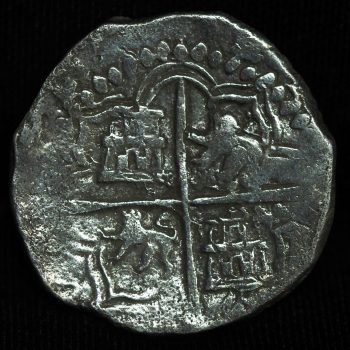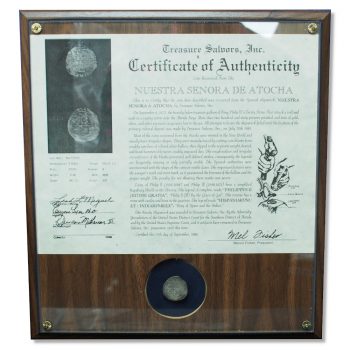What are Atocha Coins?

Many people often see our shipwreck coins and ask, what are atocha coins? Atochas, named after the legendary Spanish ship “Nuestra Señora de Atocha,” are a treasure trove of history and intrigue. These coins were part of a vast collection of silver and gold transported from the New World to Spain during the 17th century. The Atocha ship, laden with riches from the Spanish colonies in the Americas, met a tragic fate when it sank off the coast of Florida in 1622, succumbing to a fierce hurricane. Over three centuries later, the wreckage was discovered by treasure hunter Mel Fisher, unearthing an astonishing treasure, including thousands of Atocha coins.
Are Atocha Coins Rare?
Absolutely, Atocha coins are exceedingly rare and highly sought after by collectors and enthusiasts. Due to the historical significance, limited supply, and the captivating story behind their recovery, Atocha coins have become iconic in the world of numismatics. The allure of owning a piece of history, recovered from the depths of the ocean, contributes to their enduring appeal.

Is my Atocha Coin Valuable?
Indeed, these coins are incredibly valuable, both historically and monetarily. These coins, recovered from the shipwreck of the “Nuestra Señora de Atocha,” are considered some of the most sought-after treasures in the world of numismatics and historical collectibles. Their worth is derived from their historical significance as relics of the Spanish colonial era and their rarity due to the circumstances of their discovery. Atocha coins often command substantial prices in the market. Their values vary based on factors such as denomination, condition, and provenance. Beyond their monetary value, owning an Atocha coin is like holding a piece of history. It connects you to the golden age of the Spanish Empire and the captivating tale of a sunken treasure ship.
Looking to Sell Your Atocha? Get Paid Top Dollar!
What Does the Atocha Coin Symbol Mean?
The Atocha coin symbol holds a wealth of symbolism. It features a castle (representing the Spanish mints) and a lion (symbolizing the kingdom of Castile). This classic design, with the cross on the reverse side, has been a hallmark of Spanish colonial coinage for centuries. Beyond its aesthetic appeal, it signifies the economic and political power of the Spanish Empire during its golden age.

How Do I Know if My Atocha Coin is Real?
Authenticating an Atocha coin is crucial due to the presence of numerous replicas and fakes in the market. To ensure your Atocha coin is genuine, consider these factors:
- Provenance: Authentic Atocha coins come with well-documented histories and certificates of authenticity, tracing their recovery back to the shipwreck.
- Mint Markings: Inspect the coin for mint markings, date, and denomination, as these should align with the historical records.
- Material and Patina: Genuine Atocha coins are made of silver or gold and often bear the effects of centuries underwater, such as a distinctive patina. It is imperative that the coin is never cleaned, as this could severely ruin the value and integrity of the coin.
- Reputable Sellers: Purchase from reputable dealers or auction houses specializing in Atocha coins. Expertise matters when verifying authenticity.
- Professional Appraisal: When in doubt, seek the expertise of a professional numismatist or appraiser who can authenticate your coin. Most coins come certified through the NGC or other grading companies.

Why Do People Wear Atocha Coins as Necklaces?
People wear Atocha coins as necklaces for a combination of historical significance and aesthetic allure. Atocha coins, recovered from the fabled shipwreck, carry with them a captivating story of adventure and the riches of the Spanish colonial era. By wearing these coins as necklaces, individuals connect with this fascinating history, immersing themselves in tales of lost treasures and sunken galleons. Additionally, the coins themselves, with their unique designs and the natural patina acquired from centuries under the sea, possess a striking visual appeal.
Because each coin can be different shapes, many people create custom bezels that elegantly showcase these coins as pendants. This allows enthusiasts to wear their cherished pieces of history with both pride and style.
What is a Reale?
A “Reale” (plural: “Reales”) is a denomination of Spanish currency, often mentioned in the context of Atocha coins. Reales were commonly used throughout the Spanish Empire, including its American colonies, and played a significant role in international trade during the colonial era. The value of a Reale varied over time and across regions, but it was typically a silver coin and served as a standard unit of currency in many transactions.
What is the difference between a 4 Reales Coin and an 8 Reales Coin?
The primary difference between a 4 Reales and an 8 Reales lies in their denomination and silver content. Both are historic Spanish colonial coins, but the “Reales” denomination signifies the coin’s value. A 4 Reales coin is worth half of an 8 Reales coin, with the latter being the Spanish colonial equivalent of a silver dollar. The 8 Reales, often referred to as a “Piece of Eight,” was the most widely used silver coin during the colonial era, known for its widespread acceptance in international trade. In contrast, the 4 Reales represented a smaller denomination, still valuable but more suited for everyday transactions in the bustling markets of colonial America. Both coins offer intriguing glimpses into the economic and numismatic history of the Spanish Empire and its global influence.
In conclusion, Atocha coins are not just rare collectibles; they are tangible links to a remarkable chapter in history. Their scarcity, iconic symbols, and the thrill of their discovery continue to captivate the imaginations of those who appreciate the intersection of numismatics and adventure. Remember the importance of authenticity and the rich history that accompanies these remarkable treasures from the depths of the ocean.
Want to own a piece of unbelievable history?
- Categories:
